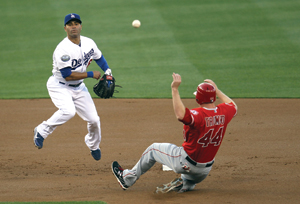MLB’s new-look schedule for 2013, featuring everyday interleague play for the first time, is being seen by league and club officials as a potential boon for attendance.
League schedule makers for years have sought to construct schedules with boosting ticket sales in mind, balancing those commercial interests with local needs and travel rules in the collective-bargaining agreement with the MLB Players Association.
But next year’s slate, released last week and driven by the pending realignment of the Houston Astros to the American League, presents the largest set of changes to the league schedule since interleague play began in 1997 and MLB expanded to 30 teams the following year. Most notably, the perennially popular interleague play will be spread across the entire season (see box).
 |
The slate includes the most changes to the schedule since interleague play began in 1997.
Photo by: GETTY IMAGES
|
Key interleague series such as the New York Yankees against the New York Mets and the Chicago White Sox against the Chicago Cubs have been moved from summer weekends to a new Prime Rivals week in which each team will play its primary interleague rival on four straight weeknights in late May.
The creation of Prime Rivals week takes what have been some of the biggest crowds of the year for most teams and places them on dates that have been historically weaker draws in many markets. A similar dynamic can be seen in highly anticipated meetings such as four games between the Yankees and Los Angeles Dodgers next year that will all be played on weeknights.
“It’s definitely a new look at the schedule, and it’s something I certainly hope the fans will enjoy,” said Brooks Boyer, Chicago White Sox senior vice president of sales and marketing. The White Sox have played nearly all season in a tight division race with Detroit but still have struggled with attendance at U.S. Cellular Field, ranking seventh worst in baseball at press time with an average of 24,457 a game.
Schedule shifts
■ Everyday interleague play: Instead of confining it from mid-May to late June and placing many matchups on weekends, interleague play will occur throughout the season. Each team will play 20 interleague games, up from 18.
■ Regular rotation within interleague: After years of more haphazard groupings, NL West teams next year will play those from the AL East, the AL West will face the NL Central, and the AL Central will play the NL East.
■ Increased divisional play: Each team will play 19 games against each club in its own division, up from 18.
■ Decreased nondivisional league play: Nondivisional league opponents will play each other six or seven times, down from as many as 10 times.
■ Return season’s start to Sunday night and Monday: The league used midweek beginnings for the last two years.
■ Prime Rivals week: Main interleague rivals will play each other on four straight days in late May, with two games at each team’s home park. Main interleague rivals had played two three-game series.
— Eric Fisher
Several teams last week said they were unhappy with the loss of a third home date against their primary interleague rival in the new format. But after some discussion of potentially moving to a more balanced schedule, clubs will still play the majority of their games against their four divisional rivals, providing some consistency among the changes.
“Keeping the unbalanced format, I think, is a big positive and gives real credence to the division title,” said Dave St. Peter, Minnesota Twins president. “Our fan polls showed some of our folks would prefer to have a bit more variety in the opponents coming through our park. But having those deeply built natural rivals is still really important in what we do.”
MLB was somewhat prepared for the arrival of the new alignment placing 15 teams each in the American and National leagues, having developed several prototypes in recent years during prior realignment talks. Creating the finished product required resolving the question of what to do with its annual “squeeze week.” In part because of lost days around the All-Star Game, each MLB team every year plays one week with three separate series instead of the usual two.
The creation of Prime Rivals attempts to boost the prominence of the squeeze week while also in many instances lessening team travel during the period.
“Prime Rivals was definitely a big part of the discussion, getting those two-game series in the schedule, and what we were going to do with that week,” said Katy Feeney, MLB senior vice president of scheduling and club relations. “We’re hopeful on how this is going to work out.”
MLB attendance this year has cooled considerably in recent weeks after a torrid start to the season. A year-over-year increase that neared 8 percent in the late spring was below 3 percent last week, at an average of 30,952 a game. Such a dynamic is common as school begins again and vacation travel drops considerably. Still, if the current growth rate holds, it will give MLB a second straight annual increase after three straight years of declines, as well as the fourth largest overall attendance in league history.




